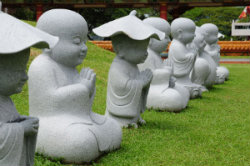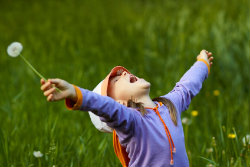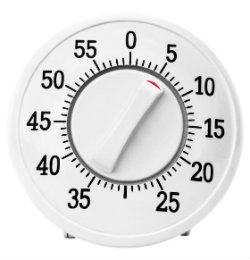You’re familiar with what happens when a baby faces food for the first time. The food often ends up on the baby’s face! That’s because babies have an innate curiosity about everything in the world around them. When they run across something they’ve never seen before, they touch it, they smell it, they taste it – and they even rub it on their face.
You could say the baby’s action is akin to mindfulness, or paying acute attention to the world by focusing on our sensory perceptions. Mindfulness is a way of viewing and being in the world that can enhance your life, and especially the life of your anxious child.
Mindfulness Explained
Mindfulness is a way of exploring the world with a fresh set of eyes. The concept can be broken down into a three part equation, or what The Mindful Child author Susan Kaiser-Greenland calls the ABCs:
- Attention
- Balance
- Compassion
Mindfulness is a way of being in the world that incorporates an acute attention to your senses and everything around you, a sense of balance that leads to a steadiness in both the mind and heart, and a dose of compassion, both for yourself and again for everything around you. It is a place that features awareness without judgment; there is no good or bad, no right or wrong, no gorgeous or ugly – there just is.
Mindfulness is nothing new, although its popularity for helping anxious children is a relatively recent development and its benefits unknown to most that haven’t been exposed to it through more advanced and leading edge material such as what we offer. Relatively, that is, since the history of mindfulness itself stretches back to Buddhism, where the concept emerged through Eastern meditation practices.
Mindfulness vs. Meditation
 Although mindfulness may have originally stemmed from meditation, and meditation is a great tool for learning to achieve mindfulness, meditation and mindfulness are decidedly not one in the same. The goal of mindfulness is to achieve an acute awareness of the world and your place in it. Meditation, on the other hand, may strive to achieve a higher state of consciousness or to take yourself out of your surroundings by focusing on a single thought, chant, or object.
Although mindfulness may have originally stemmed from meditation, and meditation is a great tool for learning to achieve mindfulness, meditation and mindfulness are decidedly not one in the same. The goal of mindfulness is to achieve an acute awareness of the world and your place in it. Meditation, on the other hand, may strive to achieve a higher state of consciousness or to take yourself out of your surroundings by focusing on a single thought, chant, or object.
Mindfulness does not aim to take you or your anxious child away from the world, but rather place you more firmly in it. Using meditation as a way to understand, grasp and develop mindfulness is a fabulous first step, but the ultimate goal for you and your anxious child is to be able to employ and enjoy mindfulness throughout your daily lives in everything you do, or “off the cushion,” as it’s called.
MBSR
Mindfulness is also a key component in (and part of the name of ) a technique called MBSR, or Mindfulness-Based Stress Reduction. MBSR was popularized by a guy named Jon Kabat-Zinn, founding executive director of the University of Massachusetts Medical School’s Center for Mindfulness in Medicine, Health Care, and Society.
As a Ph.D. and researcher, Kabat-Zinn delved deep into the way the mind and body interact when it comes to healing, and found the mind can do astounding things for the body. The MBSR program consists of a series of classes that aim to teach you mindfulness meditation practices, mindful yoga and stretching, discussions, instruction and assignments all geared toward helping you use mindfulness to reduce stress and enhance your daily life.
The first few weeks of the program are aimed at getting you to pay attention to your body sensations, a way of teaching you how to control your focus and attention. You continue to grow and develop your control from there, using mindfulness to help alleviate stress and things that ail you.
MBSR has been used to effectively treat headaches, high blood pressure, chronic pain and illness, sleep problems and fatigue, stress and distress, and panic and anxiety. With such widespread benefits, program participants have included everyone from judges to CEOs with Olympic athletes in between. If MBSR can do so much for so many, just think what a little general mindfulness may be able to do for your anxious child. Better yet, we’ll tell you.
How Mindfulness Can Help Your Anxious Child
 Because mindfulness switches you and your anxious child’s perceptions from your swirling thoughts to the sensory perceptions of what’s happening around you, emotional reactions can instantly deflate. An all-consuming panic or tantrum can lose its power in mere seconds, leaving a sense of calm and control.
Because mindfulness switches you and your anxious child’s perceptions from your swirling thoughts to the sensory perceptions of what’s happening around you, emotional reactions can instantly deflate. An all-consuming panic or tantrum can lose its power in mere seconds, leaving a sense of calm and control.
Anxious children get a whole different sense of being in the world that is far removed from their thoughts and emotions. They can better see what’s going on around them and develop specific skills that help them become more settled, with a steady mind and a steady heart and an overall sense of well-being. Kaiser-Greenland adds they become kinder, more compassionate and more generous.
Anxious children are often overly concerned with disasters they think may happen in the future or fear dangers that don’t exist in reality. Mindfulness gently brings the anxious child back into reality to see no danger is present, no tragedy is unfolding, and no disaster is lurking beneath their feet.
Other benefits are pointed out by authors Karen Hooker and Iris Fodor in their report “Teaching Mindfulness to Children.” Mindfulness can benefit the anxious child by:
- Bringing attention back to the present, away from worries of the future
- Reducing stress
- Breaking the cycle of worry, where one fear feeds on another until it snowballs into full-blown anxiety or even a panic attack
- Teaching them to identify, become aware of and accept emotions, rather than simply be consumed by them
- Allowing them to practice awareness and acceptance without judgment
- Improving their memory simply by improving their ability to pay attention
- Enhancing their ability to focus and learn
- Letting them experience and understand their thinking process and how their mind works, both of which can lead to a greater understanding of self and their personal experiences in the world
Research that Supports Mindfulness Benefits for Anxious Children
All the benefits that come out of mindfulness are not just theories either. Research suggests mindfulness and mindfulness mediation practices can actually change areas of your brain engaged in the practice as well as control specific brain waves.
A study published in Frontiers in Human Neuroscience showed that subjects that had been long-term meditators had different patterns on certain areas of the brain. This suggested the areas used for meditation’s introspection, emotional control and awareness developed at a different level than those who did not meditate regularly. Such developments may have an impact on the autonomic, affective and cognitive processes.
Another study, this one published in the Brain Research Bulletin, found that subjects who meditated were better able to control certain brain waves than those who did not meditate. Subjects who were taught to meditate over a two-month period had better control over a specific brain wave known as alpha rhythms, which are responsible for helping you focus.
“These activity patterns are thought to minimize distractions, to diminish the likelihood stimuli will grab your attention,” senior study author and MIT neuroscientist Christopher Moore says in MIT News. “Our data indicate that meditation training makes you better at focusing, in part by allowing you to better regulate how things that arise will impact you.”
Myths about Mindfulness and Meditation
Despite all its benefits and uses, mindfulness and meditation still has a ton of myths attached. Some may read about the good stuff that comes out of the practice, but shy away from actually practicing either due to false beliefs that make mindfulness or meditation seem like something they could never even try. You don’t have to be a monk – and you don’t even have to be bald. You just have to have an open mind and open heart and the willingness to try.
Explaining Mindfulness to Anxious Children
Explaining mindfulness to your anxious child doesn’t have to be difficult, either. In fact, the simpler you keep it, the better chances he or she will understand it. How deeply you delve into the mindfulness concept largely depends on the age of your child and is something we discuss in far greater detail along with much more in our full program.
Infant to age 3
Like the baby who explores every angle of her food before she even puts it anywhere near her mouth, the youngest kids are already practicing mindfulness without even realizing they’re doing it. The Daily Beast notes the tale of a toddler who would crawl into his mother’s lap while she was meditating, a method you could try on the youngest kids just to get them into the habit of sitting quietly and mimicking what you do.
Age 4 to 6
Using sensations is an ideal way to get this age group into the mindfulness groove. Tell them to really pay attention to their place in the world by paying attention to their five senses. Ask them to describe the sensations in their fingertips, the solidness of the ground beneath their feet, the taste, feel and sensation of every single bite of food they take.
In addition to mindfulness sessions you create daily, spot-check them throughout the day by asking them to stop whatever they’re doing and thinking and really pay attention to the world around them. Use concrete objects and things they enjoy, like coloring books and toys, to get them in the moment and interacting with the world around them.
Age 7 to 12
The same explanation you used for the age 4 to 6 group will work for the 7 to 12 group, and now you get to add a little extra explanation to the mix. Here’s where you can introduce the concept of paying attention, being balanced and having compassion into the mindfulness mix.
You can also introduce mindfulness as paying acute attention of the way their body interacts with the world and observing that interaction without judgment. Likewise note they can observe the way their mind works and no longer have to be swept up in emotions or fears.
Teens and Tweens
Here’s where the real fun of mindfulness can begin, with anxious kids old enough to understand and share their specific perceptions of the world. They may even be able to trace their perceptions to their origins to figure out why they may harbor certain judgments of objects or situations where no judgment needs to be attached.
You can share your mindfulness experiences when you’re working on activities together, spot-checking each other throughout the activity to remind yourselves to pull your mind away from your internal thoughts and focus it on the sensations of your present reality.
Starting a Mindfulness Meditation Practice with Anxious Kids
 The number one rule of starting a mindfulness meditation practice with your anxious child is to make sure you practice what you preach, so to speak. Getting your own firm grasp on what mindfulness means and how to go about practicing meditation with mindfulness as your aim is a must before you can successfully teach it to others. Once you’ve grasped the concept, mindfully, a number of tips can help you introduce your anxious child to a mindfulness meditation practice.
The number one rule of starting a mindfulness meditation practice with your anxious child is to make sure you practice what you preach, so to speak. Getting your own firm grasp on what mindfulness means and how to go about practicing meditation with mindfulness as your aim is a must before you can successfully teach it to others. Once you’ve grasped the concept, mindfully, a number of tips can help you introduce your anxious child to a mindfulness meditation practice.
Start small. The youngest kids may need to start with a session as short as five, or even three, minutes until they can learn to sit still and settle for longer periods of time.
Make it a daily habit – for both you and your anxious child. Set a specific time aside every morning or evening, either before the hurly-burly activities of the day or after all the chaos has died down. Mark the session on your schedule and stick to it daily, the same way you’d perform other daily tasks such as eating breakfast or brushing your teeth. Once the habit of mindfulness forms during meditation, you anxious child can more easily take it “off the cushion” and into their daily lives.
The Power of Habit author Charles Duhigg says our habits are formed by a three-part process: a cue, a routine, and a reward. The cue is moving into a quiet area, the routine is daily practice, and the reward is an increased awareness of the world. Once ingrained enough through the three-part process, mindfulness can become habitual for both you and your anxious child.
Let your kid be creative. Kids will often be able to “see” their breath or stress in their body much better than an adult, a prime reason guided meditations and imagery can be so helpful for children with anxiety. It may be difficult for you to get in touch with your stress or anxiety, but a child can easily watch it flow in their body, give it a color, and assign it other attributes that allow them to more easily control it better.
Don’t rule out bribery, especially in the beginning. Incentives can be a big boost for helping to achieve a goal. A study out of Chapman University showed the coupling of incentives with a strong, concrete goal led to the highest rate of desired outcomes. In this case, the goal is a mindfulness meditation session, the incentive is of your choosing, and the outcome can be your first successful session with your anxious child!
Incentives don’t have to consist of a new toy or junk food, they can be something as simple as a solid dose of praise or some extra time playing on the floor with mom or dad. Praise or extra playtime can often make your kid light up far brighter than anything you could buy.
Build a “sanctuary” with them. Let your kid pick out stuff that they think will help them relax and be calm. Forget noisy and colorful toys, but pick up a few special stones while out on a walk or small plants they admire. Let them be involved in building this special place that is not for jumping and playing but instead set aside for quiet and calm to get them in the mood for meditation.
Getting Started in 5 Minutes
 You’ve reviewed the tips, set up the sanctuary, and now you’re ready for you and your anxious child’s first meditation session. Congratulations! Here are five super-quick steps to get started.
You’ve reviewed the tips, set up the sanctuary, and now you’re ready for you and your anxious child’s first meditation session. Congratulations! Here are five super-quick steps to get started.
- Sit in a quiet area away from distractions (turn off your cell phone!).
- Remain still and quiet, breathing naturally for at least 1 minute, as your mind and body begin to relax.
- Explain to your child you are going to close your eyes and count your breath in your mind as you sit for 5 minutes. Illustrate the counting by doing it for your child and counting out loud. Breathe in and count one, breathe out and count one. Breathe in and count two, breathe out and count two, and so on.
- Set a timer for 5 minutes, or whatever length you desire for the first session. A simple egg timer or kitchen timer will do.
- Have your child close their eyes and begin the breath counting in their mind as you do the same until the timer goes off.
- Compare notes on what the session was like. What did it feel like? What did your mind do? Discuss any other topics that come up.
Then meet up to do it again tomorrow!
SOURCES:
- http://www.frontiersin.org/Human_Neuroscience/10.3389/fnhum.2012.00034/abstract
- http://web.mit.edu/newsoffice/2011/meditation-0505.html
- http://www.mindfuleducation.org/mindfulnessforchildren.pdf
- http://cme.ucsd.edu/bridging/slides/Kaiser%20Greenland%20-%20Article.pdf
- http://www.mindfuleducation.org/mbsrforchildren.pdf
- http://www.dhs.wisconsin.gov/mh_bcmh/docs/confandtraining/2011/5-12-11Mindfulness.pdf
- http://takingcharge.csh.umn.edu/interviews/teaching-mindfulness-children-interview-susan-kaiser-greenland
- http://www.thedailybeast.com/articles/2010/08/03/meditation-techniques-for-children-how-to-calm-your-kid.html
- http://www.childmind.org/en/posts/articles/2012-4-23-mindfulness-classroom
- http://web.mit.edu/newsoffice/2011/meditation-0505.html
- http://www.sciencedirect.com/science/article/pii/S0361923011001341
- http://web.mit.edu/bcs/graybiel-lab/publications/Science_Jog.pdf
- http://www.chapman.edu/research-and-institutions/economic-science-institute/_files/WorkingPapers/minambres-corgnet-gonzalez-goal-setting-and-monetary-incentives.pdf
- http://www.npr.org/2012/03/05/147192599/habits-how-they-form-and-how-to-break-them





